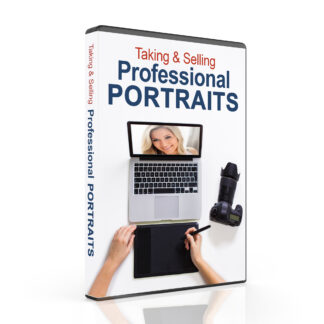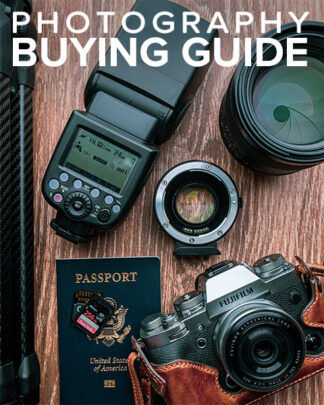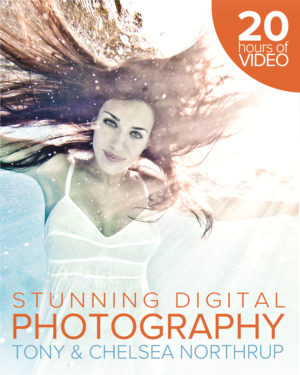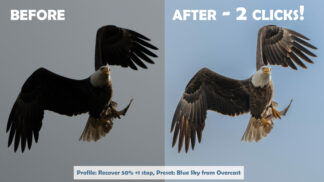I know many people don’t care about comparing features or understanding technical details; they just want a simple answer to their questions. If you don’t already have a camera, here are my recommendations. If you do already have a camera that’s a different make than I recommend, feel free to buy the lenses I recommend for your camera body.
Do You Really Need More Gear?
Here’s something to keep in mind: I’ve helped review thousands of reader photos, and if the picture can be improved, I tell the reader exactly how to improve it. Only about 2% of the time do I recommend people upgrade their gear, and the vast majority of those times, I’m recommending adding an external flash or using a different lens. Only a couple of times have I recommended someone upgrade their camera body. The lesson to be learned from this experience is that most people don’t need more gear to make better pictures. They just need more practice and some post-processing. For the people who do need to buy gear, most of that money should go to lenses and lighting. The cost of your camera gear is not a reflection of your skill. Many people think that as they improve their photography skills, they should also improve their gear. Only seek out new gear when your current gear is failing you.
Bang for Your Buck
Most of us have limited budgets and need to consider which purchases will do the most to improve our pictures. Let’s look at a couple of examples. First, consider an amateur landscape photographer with the entry-level, 24-megapixel Nikon D3300 and its kit lens. His photography has gotten excellent, so he’s considering upgrading to the much more expensive 36-megapixel D810. The D810 is my favorite camera in the world, but for his needs, I’d tell him to keep the D3300 and spend the $3,500 he had budgeted for the upgrade on a trip around the world, visiting all the most beautiful landmarks with his D3300. If you’re a landscape photographer, you’ll see far more improvement if you spend your budget on travel and practice. Now, consider a mom with the excellent Sony a6000. She loves taking pictures of her son’s indoor basketball games, but many of the shots are out of focus. I’d tell her that her camera isn’t well suited to the task because (in our tests) it doesn’t track moving subjects as well as a DSLR. I’d recommend she sell her a6000 and buy a Nikon D5300. In this scenario, changing hardware will definitely improve her pictures, even though the camera isn’t more expensive. The landscape photographer would be better off spending his money on travel, while the sports photographer actually needed an upgrade. A portrait photographer might get better portfolio pictures by hiring a model and a makeup artist, or by buying lights. The best way for you to exchange money for improved pictures might not be by buying equipment—but it could be. In this book, I’ll try to give you the information you need to decide for yourself.
Your First Camera
I’ve talked with hundreds of people in the process of buying their first camera. Here’s the process they usually follow:
- Look at a reasonably priced camera kit for sale.
- Notice a camera that has a few more megapixels and costs slightly more.
- Start looking at incredibly complex camera reviews, such as those at dpreview.com.
- Discover crazy people who are passionate about nonsense such as high ISO performance, dedicated depth-of-field buttons, or Canon vs. Nikon vs. Sony.
- Become flustered when they can’t decide between two or three different similarly priced bodies and worry that they’re going to get the wrong camera and forever be cursed with taking awful photos.
Here’s the process that I’m going to walk you through:
- Determine a total budget that you’re comfortable with.
- Determine how much the accessories are going to cost you.
- Buy any camera you can afford with the remaining money—used, if possible.
My primary goal is to get you out and taking pictures as quickly as possible. The fact is, your first camera really doesn’t matter that much. Even the most basic camera kit is capable of amazing pictures. None of your Facebook friends are going to be able to tell the difference between a photo taken with a $300 camera or a $6,000 camera, but they will notice the difference when you master composition, lighting, and posing. When searching for Nikon and Canon DSLRs at Amazon, I see kits ranging from under $300 to over $6,000. What do they all have in common? An average review of 4.5 stars—every single camera. They’re all amazing cameras, and available at every price point, and the people who use them love them. You literally can’t go wrong. If you’re afraid you’ll buy the wrong camera and regret it, let me comfort you. If you become a casual photographer, any camera will do fine. If you become a serious photographer, you’re going to want to upgrade your gear no matter which you buy. You don’t know which gear is right for you until you get some practice shooting, however, because you haven’t developed a style or discovered which types of photography you love. As your skills develop, there might come a point when your camera equipment can’t keep up with you. At that point, you’ll be able to sell your existing gear and get most of your money back (especially if you followed my advice and bought used in the first place), and put your money towards gear suited exactly to your specific style. This site is for people who don’t yet own a camera with interchangeable lenses, or who need guidance purchasing accessories. If you already have a camera that you’re happy with, skip this book and spend the time taking pictures. I’ve talked to thousands of readers, and the most common mistake is buying too much camera gear too soon in their photography career. Sometimes, buying new gear is the answer to a problem, but most of the time, getting more experience or spending more time planning is a better answer. Here’s more detailed information: [html_sitemap child_of=CURRENT]






Comments are closed.